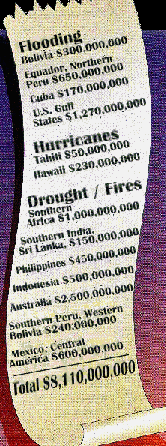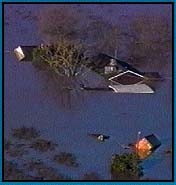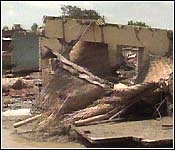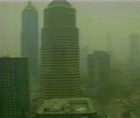| Home |
World
Impact Map
Effects on Man and Nature
Effects on Man and Nature
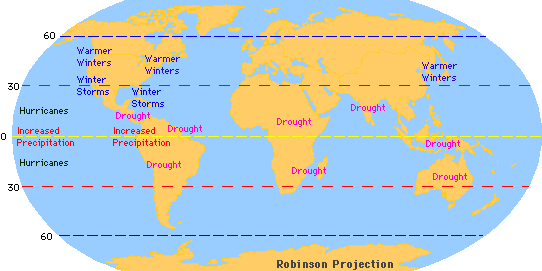
In meteorology, few things matter more than
warm ocean puddles. They provide the thermal energy that
seers evaporation and hence loud formation and storms.
The extra heat with the water acts like wood tossed on a
fire, creating more and bigger storms. Thus, El Niņo's
appearance creates a ripple effect worldwide, but its
effects are more apparent in the Pacific region.
So, what has El Niņo done that has so
drastically affected man? Below is a short, but not
exhaustive, list:
El Niņo contributed to
record global warmth in 1997
The very
strong El Niņo-Southern Oscillation (ENSO)
episode was a major factor that contributed to
the record high global temperature in 1997,
according to the World Meteorological
Organization (WMO). Based on analyses contributed
by major climate centers and inputs from the
national Meteorological and Hydrological Services
of WMO Members, the estimated global mean surface
temperature for land and marine areas averaged
0.44°C above the 1961-90 base period mean
temperature. The previous warmest year was 1995,
which had an anomaly of +0.38°C. Temperatures in
the tropics (30°S-30°N) were the second highest
in the historical record and, in the
mid-latitudes, temperatures averaged above normal
during the year over a large part of central and
western Russia, western Europe, and Alaska and
the west coasts of the Americas. Areas that were
colder than normal included the eastern
two-thirds of North America, the Middle East,
northern India and large parts of Australia.
Thanks to El Niņo,
the world experienced its warmest February since
global record keeping began in 1856. According to
a report released by the World Meteorological
Organization, the average air temperature around
the world was 1.35oC higher than
normal for February. The report also said that
the northern hemisphere had its warmest February
since 1950. Disastrous floods in eastern Africa
which were attributed to El Niņo have lessened
for the first time since October 1997. On the
fire-ravaged island of Borneo, temperatures
matched the previous highest temperature of 39oC
recorded during the 1982-83 El Niņo.
United States Impact
- Since early
1998 the big island of Hawaii has been
experiencing severe drought caused by El
Niņo. From a lack of rainfall Hawaii and
the neighbouring islands of Maui and Oahu
are extremely dry. A stagnant weather
pattern, dominated by a high pressure
system, has diverted moisture bearing
storms away from the island. Parts of
Hawaii normally gets 3000 mm of rainfall
a year, this year rainfall has been a
fraction of that. In some regions
residents had to cut their water usage by
30 per cent, and crop looses were
estimated from 20 to 100 per cent.
Tourists to the Islands are greeted by
signs warning them about the drought and
asking them to conserve water.
- El Niņo -
Not all bad news for the United States.
Owing to the mild winter weather, energy
demand for heating has dropped by 10
percent. According to the U.S. Department
of Energy, Americans spend approximately
$50 billion annually on heating their
premises. A 10 percent reduction in
energy use would translate into a saving
of about $5 billion this winter. El Niņo
has also reduced the potential for
property damage from hurricane activity
on the east coast of the U.S. - a saving
of $1 billion.
- On February
22, severe El Niņo-driven storms hit in
and around Orlando, Florida killing at
least 36 people and injuring more than
200. The storms spawned tornadoes that
damaged or destroyed dozens of buildings,
knocked out power lines and uprooted
trees. Wind gusts were estimated at 400
km/h. Emergency Management authorities
described the disaster as the worst day
of tornadoes ever to hit central Florida.
- Rainfall
records toppled as a series of storms
continued to lash California. By
mid-February, San Francisco had received
a total of 872 mm of rain since July 1,
which compares with the 954 mm received
for the entire 1982-83 season - another
strong El Niņo year.
- The director
of the National Oceanic and Atmospheric
Administration predicted: "We think
that the character of the rain response
in areas like Florida, southern
California and central California is
going to be very much like it has been
for the last month or two months".
So far this season, El Niņo related
storms have caused damages estimated to
be in the $500 million to $1 billion
range in the United States.
- By late
December record breaking storm dumped up
to 25 cm of snow in southeastern U.S.
While parts of Louisiana recorded unusual
December snow, the often frigid and snowy
American Midwest basked in the warm
weather as the temperatures climbed near
20oC. A few days later, heavy
rains flooded parts of Texas. Eight
people died owing to the storm related
accidents.
- El Niņo
-powered storms slammed into southern
California during the first week of
February. Over 150 mm of rain in less
than 24 hours chased thousands of people
out of their homes to higher ground.
Santa Barbara county received the
heaviest rain - 325 mm on February 8th.
The devastating effects of strong winds
and torrential downpour was described as
nothing short of a 'bomb' by local
residents. The storm stretched the length
of California. Waves up to 4 meter high
crashed ashore south of San Francisco. In
the Napa valley, some 5,000 acres of
vineyards were under flood water.
Tropical Impact
As always, the
effects of El Niņo are more direct and dramatic
in the tropics. Some impacts of this year's El
Niņo in these areas include:
- El Niņo
devours Peru's highways. El Niņo driven
floods have washed away 992 km stretch of
the Pan-American highway north of Lima.
Torrents of rain have turned the
otherwise dry river beds and ravines in
Peru's northern desert into raging
rivers. The rushing waters have swept
away villages and cut highways into
ribbons. El Niņo even dug up the dead.
Rain-swollen lagoon burst its banks in
mid-February and swept over a cemetery
gouging the dead from the ground. The
rains have caused 50 bridges to collapse
and another 28 have been damaged across
Peru. In March, a Peruvian air force
plane, evacuating people stranded by El
Niņo floods, crashed in Piura killing 12
people. Excessive rains have helped to
merge two small lagoons which formed a 80
km long lake dubbed "El Niņo"
by local inhabitants.
- El
Niņo-related heat encouraged widespread
breeding of mosquitoes in South America.
El Niņo helped to set record high
temperatures in Peru, Columbia and Chile.
The heat wave and wide fluctuations in
the climate have brought more insects
like mosquitoes carrying malaria and
other dangerous diseases like dengue
fever. Despite all the efforts made to
introduce preventative measures,
authorities in Peru fear an epidemic in
malaria-related cases.
- Since October
1, 1997, five to ten times the normal
rain fell on northeastern Kenya and the
east-central Ethiopian highlands. Major
flooding continued in southern Somalia
along the Juba and Shabelle Rivers
claiming more than 1,200 lives and
forcing hundreds of thousands of
inhabitants from their homes while in
eastern Kenya, the swollen Tana River has
left thousands homeless, disrupted
transportation, and caused extensive
property damage.
- El
Niņo-related rainfall deficits were
recorded over Central America and the
Caribbean, northern South America and in
an area extending eastward across the
tropical South Atlantic. Other impacts
included a decrease in tropical storm and
hurricane activity across the subtropical
North Atlantic. During the June-October
period, an El Niņo -related increase and
eastward extension of jet stream winds
and storminess across the central and
eastern South Pacific to southern South
America resulted in wetter-than-normal
conditions throughout parts of central
and southern South America. This El
Niņo-related rainfall was associated
with anomalously strong low-level
easterly winds across the central
equatorial Indian Ocean.
- El Niņo
induced dryness helped to ignite dozens
of severe brushfires on the outskirts of
Sydney Australia. Two people have died,
thousands evacuated from their homes. The
fires destroyed at least 40 homes.
- Tropical
cyclones are predicted to be more
frequent in the South Pacific islands
this summer, especially in the Cook
Islands and French Polynesia, according
to New Zealand National Institute of
Water and Atmospheric Research.
- Severe
drought in some areas of Indonesia due to
the early arrival of the dry summer
season. This has contributed to the
extreme forest fires that blanketed South
East Asia in smoke and haze.
- Severe storms
in central Chile in June, July and
August, with rainfall totaling 10 times
the normal amount for an entire year.
Santiago, the capital, received more than
a year's worth of rain (300 mm) in June.
- The worst
drought in 50 years for Papua New Guinea.
- Prior to
Christmas, El Niņo brought more despair
to the inhabitants of New Zealand. While
severe drought claimed large areas, many
coastal regions were flooded. More than
100 millimetres of rain deluged the west
coast of the South Island and left half
of Greymouth submerged in water. El Niņo
is posing a real threat to the
agricultural community. Water is being
rationed in some areas, and with feed
drying up farmers were selling their
stocks.
- Crop and
livestock losses from dry weather already
exceeding $130 million in New Zealand.
- Sweltering
summer heat in areas of Asia from the
Indian subcontinent to China, including
the most severe heat wave this century.
- Unpredictable
monsoons in Pakistan and northwestern
India, with spotty rain in some areas and
torrential rain in others.

|

